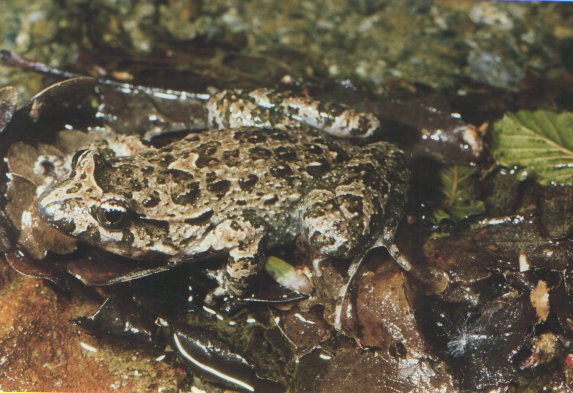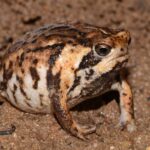Discovering Discoglossus sardus: Sardinia’s Enigmatic Painted Frog#
In the quiet streams and shadowy wetlands of Sardinia and Corsica hides a frog unusual not only in its coloration but also in its ancient evolutionary lineage: Discoglossus sardus, affectionately known as the Tyrrhenian Painted Frog or Sardinian Painted Frog. With an ancestry dating back millions of years and an impressive adaptability to changing habitats, this amphibian species embodies a unique intersection of biology, history, and conservation. Secretive, beautiful, and fragile, encountering Discoglossus sardus in its natural habitat feels like a fleeting privilege, requiring patience, silence, and a keen eye.
Taxonomy and Classification#
Belonging to one of the oldest families of amphibians—the Alytidae—Discoglossus sardus exhibits evolutionary traits linking it closely to primitive frogs. Its genus, Discoglossus, collectively known as the painted frogs, comprises species distributed primarily through parts of the western Mediterranean basin. The name “discoglossus” itself holds meaning, originating from ancient Greek; “diskos,” referring to a rounded shape, and “glossa,” meaning tongue—a nod to the frogs’ round-tipped tongue which is atypical among amphibians.
Discoglossus sardus shares close relations with other painted frogs, including Discoglossus pictus, yet remains distinct due to geographic isolation and diverging evolution. This species has developed unique characteristics that distinguish it in both form and behavior from its continental relatives, hence earning it its own specific scientific designation.
Natural Habitat#
Discoglossus sardus is predominantly native to two Mediterranean islands: Sardinia (Italy) and Corsica (France). Historically abundant across these islands, the species thrives in pristine freshwater environments, favoring clear streams, ponds, temporary marshes, and even shallow pools hidden amid calcium-rich limestone rocks. The rugged, mountainous terrains and dense maquis vegetation prevalent in these islands create essential sheltered habitats that protect them from potential predation.
A Life Among Streams and Pools#
Stand near a quietly babbling brook nestled among olive groves or within the dense scrubland of Sardinia at dusk, and you may hear the subtle symphony of Discoglossus sardus males calling softly to potential mates. These amphibians prefer quiet, shaded environments rich in organic material and free of human contamination. They rely heavily on clean waters, vegetation cover, and moderately humid conditions to survive, breed, and flourish. The presence of such frogs indicates the overall health of these aquatic ecosystems, reaffirming their importance as indicators of ecological well-being.
Island Isolation and Adaptive Evolution#
Sardinia’s insularity provides a unique narrative in amphibian survival. Separated geographically from mainland Europe by rising seas thousands of years ago, Discoglossus sardus has evolved remarkable adaptability. The island habitat has allowed it to occupy ecological niches developed in absence of competition or advanced predators, something that mainland relatives have not equally enjoyed. As a result, its behavior and biological characteristics evolved distinctly to fit the unique environmental pressures of these islands.
Physical Characteristics#
With an adult size typically between 5 to 8 centimeters, the Sardinian Painted Frog is moderately sized compared to other Mediterranean counterparts. Its unattractiveness in some frog-watchers’ eyes belies captivating charm upon closer inspection—a subtle yet exquisite mosaic of earth-toned colors, which might include olive-green mottling punctuated by caramel hues, splashes of rust-red, and occasional speckling of darker browns.
Camouflage and Survival Strategies#
This mosaic-like coloration provides exceptional camouflage among moist leaves, mudbanks, and streamside rocks. A gentle ripple or shifting leaf may be the only clue that it’s not alone by the water’s edge. The underside stays primarily pale, sometimes a gentle cream color, contrasting sharply with their intricately patterned backs. Large, sensitive eyes positioned dorsally allow them to perceive predators rapidly and leap swiftly, disappearing instantly into leaf litter or stream pools.
An Ancient Anatomy#
What particularly sets Discoglossus sardus apart is its primitive anatomical traits, indicative of its ancient lineage. Unlike many modern frog species with a protruding, sticky tongue, painted frogs possess a relatively shorter, rounded tongue. They rely instead on quick lateral motions of their jaws to capture small prey. Their skin, rich in glands that help retain moisture and fend off pathogens, stays perpetually moist—crucial for cutaneous respiration, a common amphibian trait.
Behavior and Life Cycle#
Feeding Strategies#
The diet of the Sardinian Painted Frog mainly consists of invertebrates, including insects, spiders, worms, and small crustaceans. Its hunting strategy relies on stealth and surprise rather than long-distance pursuit. After dusk, these frogs become increasingly active, creeping quietly from their hiding spots to patiently await unwary prey. Upon spotting movement, they strike swiftly and efficiently, often devouring prey whole.
Reproduction and Breeding Habits#
With the arrival of spring rainfalls signaling the ideal breeding periods, painted frogs become more conspicuous. Males produce soft, melodious mating calls—a distinct, resonant trill—to attract females toward suitable breeding pools. It’s not unusual to see groups congregating in temporal pools or shallow ponds formed by heavy rainfalls, thriving in the temporal aquatic conditions common to Mediterranean climates.
The females carefully lay gelatinous egg clusters in underwater vegetation or floating among submerged debris. Tadpoles emerge relatively quickly and grow in the protective shallows, feeding primarily on algae and minute plant material. Remarkably adaptable, the tadpoles of this species have evolved to develop rapidly in temporary pools, ensuring they mature into frogs before their watery homes evaporate amid Mediterranean summers.
Ecological Role#
A Vital Link in the Ecosystem#
Amphibians such as Discoglossus sardus fulfill crucial ecological functions as both predators and prey. By controlling insect populations, these frogs play a significant role in balancing ecosystems, indirectly supporting agriculture, human settlements, and other animal species. As a vital food source, their tadpoles and adults nourish predators such as snakes, birds, and larger aquatic mammals.
Indicators of Ecosystem Health#
Due to their permeable skin and strong dependence on both terrestrial and aquatic environments, they serve as valuable indicators of ecological health. Any shift towards pollution or undesirable ecological change within their habitat quickly and visibly impacts their populations. Monitoring their well-being provides conservationists with early, effective information regarding the overall ecosystem quality.
Threats and Conservation Status#
Facing Habitat Degradation#
In recent decades, Discoglossus sardus populations have experienced substantial habitat loss and fragmentation due to expanding agriculture, urbanization, infrastructure development, and water pollution. Pesticides and fertilizers used in surrounding farmland pollute waterways, which negatively affect their delicate aquatic habitats. Additionally, climate change-induced drought poses a significant risk, shrinking temporary spawning pools, leading to unsuccessful breeding cycles.
IUCN Conservation Status#
This species is currently classified as Least Concern by the International Union for Conservation of Nature (IUCN). However, decreasing population trends and ongoing habitat pressures highlight a fragile future. Localized efforts focused on safeguarding suitable habitats, establishing nature reserves, and implementing sustainable agricultural practices are especially critical for sustaining robust painted frog populations.
Cultural and Scientific Significance#
The presence of the painted frog on Sardinia and Corsica resonates beyond ecological value. They provide cultural richness and symbolize local natural heritage, making them important ambassadors for conservation education and community awareness among island populations.
Scientifically, Discoglossus sardus garners attention because of its ancient lineage, providing researchers important insights into the evolutionary forces shaping amphibian diversity. By studying them, scientists can better understand evolutionary adaptations, island biogeography, and ecological resource interactions under changing climate and human pressures—lessons applicable in broader amphibian conservation.
Conclusion: Protecting Sardinia’s Amphibian Gem#
Discoglossus sardus, Sardinia and Corsica’s enigmatic painted frog, reminds us how biodiversity mirrors ecology’s resilience and fragility. Despite its humble appearance, it embodies evolutionary heritage, ecological balance, and profound biological value. Protection requires more than admiration—it demands thoughtful action, responsible stewardship, and deepened collective appreciation for these little-known species.
Ultimately, safeguarding this remarkable frog means recognizing the interconnectedness of our natural world. Conserving habitats, reducing pollution, and promoting sustainable practices become not only responsibilities but privileges. The painted frog’s quiet existence whispers a story of survival, resilience, and ancient adaptation—a narrative we must ensure continues to be told for generations to come.


















